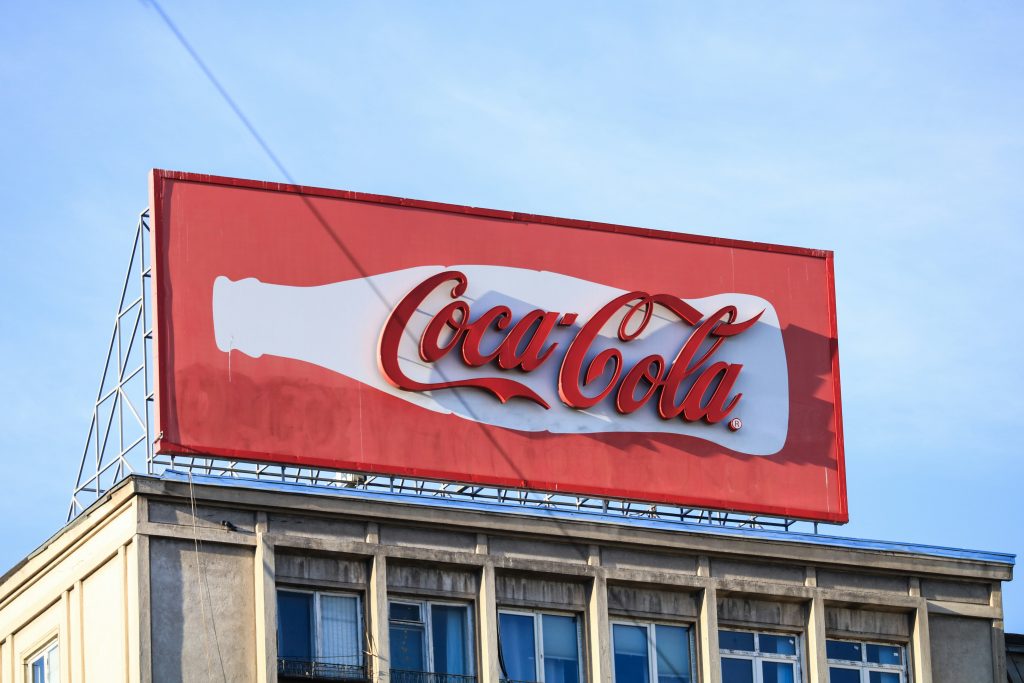To mark the launch of the company’s rebranding website, WASH Digital brings you ‘A’ for Advertising: The rattling of a stick inside a swill bucket.
Here we look at how advertising shapes the market and its transition from a predominately print-based entity to copywriting for online audiences and why George Orwell described Advertising as the rattling of a stick inside a swill bucket.
No advertising, no rattling of a stick

I feel a distinct change in the air when walking upon the streets of a post-Covid Nottingham. The fallout from the last few years is palpable.
Apart from the tragedy of homelessness – tents by the side of the pavements and washed-out individuals emerging from the gutters to ask for spare change – I have never seen so many empty shops.
Where once stood colourful logos above doorways and well-lit window designs, advertising the very latest offers, stand empty shells with grubby security posters and lonely individuals lying face-down in their own urine.
Advertising once flooded Nottingham with colourful images of hope, diversity and enticement, providing us with a taste of opportunities and potential experiences. All Nottingham speaks of now is ketamine addiction, homelessness and apathy.
Watson Fothergill and Alfred Waterhouse architecture stood as symbols of originality and hope at a time when city-centre streets were bustling with trade, Cholera, and the demise of smallpox.
Cheap nineteen-seventies pebbledash emerged to form huge shopping malls selling imported stuff we didn’t need, prior to 21st-century structures of overwhelming glass where, today, all that seems to be advertised is abandonment.
The very fact that I have mentioned that companies advertise things ‘we don’t need’ proves Orwell’s point, precisely. If there is no advertising, there is no rattling of a stick inside a bucket of swill.
And by the looks of the landmark Debenhams building that stands rotting on Long Row in Nottingham, somebody needs to rattle that stick before it collapses, amidst the sound of rats being milked by homeless vendors from the Victoria Centre indoor market.
What did George Orwell mean?
When Orwell described advertising as ‘the rattling of a stick inside a swill bucket’ in the 1936, socially critical novel, Keep the Aspidistra Flying, in which the protagonist, Gordon Comstock, has a romantic ambition to defy the worship of money and consumerism – https://en.wikipedia.org/wiki/Keep_the_Aspidistra_Flying – the line about the rattling of a stick was a stab at how advertising can be used as a weapon – as does the media – to sensationalise with avarice.
We are all aware of misleading and false advertising, as was Orwell in his day, but is advertising really the rattling stick it once was? Are the public still coerced into buying shit they don’t need, or are we all savvier these days when it comes to advertising?
The cost-of-living crisis has hit the majority of us hard and Brexit has played its part in making life difficult for families to heat the home and keep food on the table throughout winter.
Advertising is certainly scrutinised these days and Coca-Cola can’t get away with convincing mothers to start feeding it early to their children and the tobacco companies can’t advertise its carcinogenic sticks at all.
Fortunately, long gone are the classic ‘Silk Cut’ adverts and the ‘Marlborough’ brand plastered along the side of a Formula One racing car. The only cigarette advertising seen on television these days is when ‘The Simpsons’ sarcastically shows ‘Laramie’ product placements in Springfield, to mock the ways in which tobacco companies attempted to mislead the public for decades.
Although entirely different approaches are made by advertising companies these days, is it just the platform that has changed? Is the advertising game still the same as it always was?
“Everyone has gone online, me duck.”
As I looked around Nottingham city centre recently, I explained to my daughter how sorry I was that I, as an individual, was unable to help the many desperate people in a country that ranks as the 5th largest economy in the world.
At which point, a lady wearing fingerless gloves and holding a flask shouted, “It’s the norm ‘round these parts now. You had better get used to it because it’s gonna get much worse.” – and she’s not wrong.
I looked up and down a desperate-looking Lister Gate – a once vibrant hub – with H & M and a solitary Building Society sitting lonely and vulnerable between rows of empty shops, and I asked, “But where have all the shops gone?”
“They’ve all gone online, me duck,” said the woman. “And if you’re not advertising online, you’re not on the High Street.”
She was right again! To this day, word-of-mouth still speaks volumes in terms of advertising but there is a transition needed to avoid pandemics and rising prices.
If you know someone who you can trust, and they recommend a particular product or company, why wouldn’t you make that company your first port of call?
If the source is reputable then the service must be.
Trust is a big issue within business and we often talk about building a brand around a good reputation. Unethical companies who have been caught out using unscrupulous – rattling a stick – methods of coercion and manipulation are often difficult to market because, hypothetically, a business is only as good as its last meal.
Advertising has received some bad press since the ‘rattling a stick’ days and we would be hypocritical to completely condemn it, but we live in a competitive world with conflicting concerns where advertising isn’t just a form of manipulation for confidence tricksters.
Advertising is there to advise and, in some cases, warn against opposing forces. You can’t stop advertising your reputable product or service because you despise unfettered capitalism and the vanity of social media ‘likes’.
If you have a good product or service why wouldn’t you use opportunities to raise awareness of it?
Unfortunately, the emphasis is upon each consumer to determine the good products from the bad ones though the experience of buying. We have to weed through the legitimate salesmen and separate them from the rogue confidence tricksters, and then use the internet reviews to further the important buying decisions.
Advertising Origins.
If the Egyptians were responsible for one of the oldest forms of writing, they were likely the first people to use an advertisement in a written format.
There were possibly illustrated signs before 2000BC, but the Egyptians were certainly carving public notices as some form of advertising around that time.
Fast-forward about 4000 years and Egypt’s advertising has evolved digitally as the country looks to find new ways to reach audiences.
What is surprising though is the transition from print to classified advertising.
Johannes Gutenberg was famously responsible for inventing the printing press around the mid-15th-century. This was a major force for emerging economies, particularly in the 19th-century following industrial revolutions and wealth generation, at a time when technologies and advertising collided to form a significant marketing strategy.
Newspaper Advertising – the first real rattling of a stick.
The first printed advertisements likely appeared around the mid-17th-century, although the Boston News-Letter is quite specific with regards to the very first advertisement in a newspaper.
The British government-funded Boston News-Letter was the first, continuously published newspaper from April 24th, 1704, out of the colony of Massachusetts.
Of course, printed news existed long before this one but not continuous, and it just begs the question of whether those prior publications contained an advert or two.
However, history tells us that there was certainly an advertisement in the Boston News-Letter on 1st May, 1704, and that was likely to be the first newspaper advert, some 250 years after the printing press was first invented.
Today, it’s difficult for anyone to comprehend a world without advertising. It’s a massive international entity that has an impact at every level of society.
Although newspaper advertising has seen a rapid decline within the last two decades, it’s still a worldwide industry worth over $100 billion per annum, and some would vehemently argue that this kind of money equates to a rattling stick: money thrown at agencies to convince people to buy shit they don’t need – at least on the odd occasion.
Digital Advertising – the online rattling of a stick?

The spark that lit the digital advertising fire was from the moment American computer programmer, Ray Tomlinson, sent the first email in 1971.
It was then another two decades before the term ‘Digital Marketing’ was coined – https://en.wikipedia.org/wiki/Digital_marketing – as an online/internet component of advertising that emerged through the 1990s.
The development of digital technologies has been revolutionary in changing the way brands and businesses advertise, with an estimated $700 billion being spent annually by 2025.
The transition to advertising digitally has been so dramatic that it has created a preponderant industry of its own, with digital content marketers, web designers, and the crazy world of influences constantly streaming their content to the captivated eyes of the world.
In its wake is a reluctant element that refuses to use the opportunities of digital advertising to their advantage, through websites and social media platforms.
Advertising, often perceived through the eyes of George Orwell’s character, Gordon Comstock, in the 1936 novel Keeping the Aspidistra Flying, as the dirtiest ramp of capitalism, is as difficult as ever to trust.
It is often thought that, if we can’t trust our political leaders, how can we trust the business leaders who are backed by the Government?
We almost have the hyper-normalisation that Russia experienced in the 1980s where the people maintained a false pretence of a failing system. It was paradoxical period in which the Government lied to its people; the people knew it, and the Government knew that the people knew that the Government lied.
Grabbing Attention and Improving Online Presence.

Companies like ourselves are very careful not to follow the flow and get bogged down in the sycophantic bullshit. We aren’t swayed by the vanity factors of social media or the bland, robotic writing styles.
We treat each project as our own and only work with companies that would benefit from our particular brand of marketing, where we can write and design passionately with a unique, captivating tone.
Unlike the emergence of ChatGPT – https://en.wikipedia.org/wiki/ChatGPT , we have a soul and we have experience; we can experience emotion and we can change the tone in our writing style as often as we choose.
And ChatGPT doesn’t have its own distinct style. We lead with our own method of creativity that helps to drive traffic at the business-end of a website, blending traditional methods of marketing with today’s algorithm-based strategies.
We too have to determine legitimate websites from the awful ones and the rattling of a stick is more of a pixelated version these days, with lines of code and online optimisation.
At Wash Digital, we like to think of ourselves as more of an attention grabber in a large web of competing companies, rather than a rattling stick in a swill bucket. We create a buzz around a product or a service and feed the awareness through creative content that speaks honestly about our customers.
Consequently, as I have witnessed in one of the biggest cities in the country, people are now buying online instead of visiting shops, leaving city streets like post-apocalyptic dwellings with fewer consumers for the homeless to approach.
If you are looking to improve your online presence and avoid being labelled like the rattling of a stick in a swill bucket, we can help boast your authenticity and make the most of digital advertising opportunities. If this sounds like something of interest, we’d like to hear your story.
Stand out from the crowd and be ready for visitors: www.washdigital.co.uk
